Physical Address
304 North Cardinal St.
Dorchester Center, MA 02124
Echocardiographic evaluation of the patient with valvular regurgitation includes an assessment of valve anatomy, the severity of regurgitation, chamber dilation due to the imposed volume overload, ventricular function, and the degree of pulmonary hypertension. In some cases, the clinical significance of valvular regurgitation is related to the presence of abnormal regurgitation, regardless of severity. For example, the detection of aortic regurgitation (AR) in a patient with chest pain and an enlarged aorta heightens the suspicion of aortic dissection. In other situations (e.g., mitral valve prolapse), the severity of regurgitation is an essential factor in clinical decision making regarding surgical intervention. In chronic regurgitation due to primary valve disease, regurgitant severity and the response of the left ventricle (LV) to chronic volume overload are the most important factors in deciding on the timing of valve surgery.
Valvular regurgitation is due to congenital or acquired abnormalities of the valve leaflets or to abnormalities of the associated supporting structures. For example, dilation of the ascending aorta or sinuses can result in AR even with anatomically normal valve leaflets. Similarly, LV dilation can result in mitral regurgitation (MR) even with normal valve leaflets and chordae. Echocardiographic examinations allow definition of the etiology of valvular regurgitation in most cases. Even when a single definite cause is not evident, the differential diagnosis of the etiology of regurgitation often can be narrowed to the few most likely possibilities. The examination also provides clues to whether regurgitation is acute or chronic in duration.
When transthoracic echocardiographic images are not diagnostic for the evaluation of aortic or mitral valve anatomy and the etiology of regurgitation, transesophageal echocardiographic (TEE) imaging is appropriate if needed for clinical decision making. With diseases of the aorta, visualization of the ascending aorta often is suboptimal on transthoracic imaging, so TEE, computer tomographic imaging, or cardiac magnetic resonance imaging typically is needed to define the extent and severity of disease fully.
The fluid dynamics of a regurgitant valve ( Fig. 12.1 ) are, in many ways, similar to the fluid dynamics of a stenotic valve and are characterized by:
Regurgitant orifice area (ROA)
High-velocity regurgitant jet
Proximal flow convergence region
Downstream flow disturbance
Increased antegrade flow volume
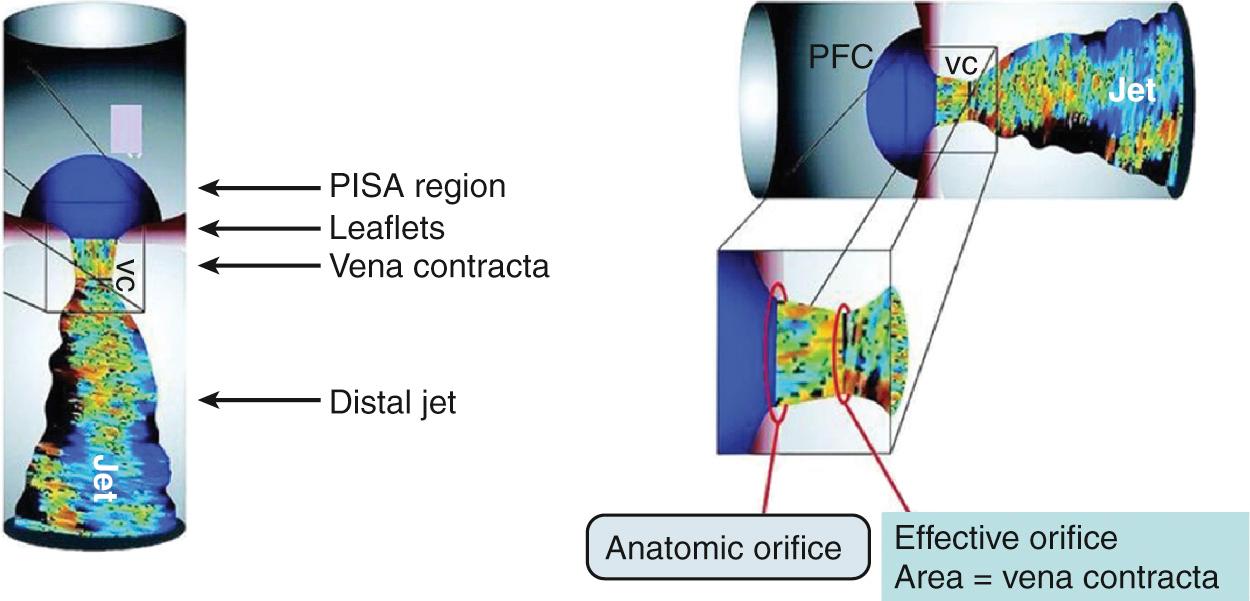
Even though the anatomy of inadequate valve closure is quite complex, the valve can be thought of as having a regurgitant orifice, which in simple physiologic terms is characterized by a high-velocity laminar jet ( Table 12.1 ). The instantaneous velocity in this jet (v) is related to the instantaneous pressure difference (Δ P) across the valve, as stated in the simplified Bernoulli equation: Δ P = 4 v 2 . Recording this high-velocity jet with continuous-wave (CW) Doppler allows assessment of the time course of the difference in pressure between the two chambers on either side of the valve.
| Fluid Dynamic Characteristic | Diagnostic Approach |
|---|---|
| Conservation of mass through the regurgitant orifice | Continuity equation for regurgitant orifice area |
| High-velocity jet in regurgitant orifice | Pressure-velocity relationship of CW Doppler curve |
| Proximal flow convergence | Proximal isovelocity surface area |
| Downstream flow disturbance | Jet area in chamber receiving regurgitant flow |
| Increased volume flow across valve | Stroke volume across regurgitant minus competent valve |
On the upstream side of the regurgitant valve, flow acceleration proximal to the regurgitant orifice is present, and a proximal isovelocity surface area (PISA) can be defined, similar to that seen on the left atrial (LA) side of the stenotic mitral valve. The proximal isovelocity surface area, multiplied by the aliasing velocity, provides a method for quantitative evaluation of regurgitant stroke volume. The narrowest segment of the regurgitant jet, the vena contracta, occurs just distal to the regurgitant orifice, with vena contracta diameter reflecting regurgitant orifice area.
As the high-velocity jet enters the chamber receiving the regurgitant flow, the flow pattern becomes disturbed with nonlaminar flow, multiple blood flow velocities, and multiple blood flow directions. The size of the downstream regurgitant flow disturbance is affected by both physiologic and technical factors and thus is less useful for the quantitation of regurgitant severity ( Table 12.2 ). In addition, the shape and direction of the regurgitant jet are affected by the anatomy and orientation of the regurgitation orifice, the driving force across the valve, and the size and compliance of the receiving chamber. Jets are “pulled” toward adjacent walls (e.g., MR in the LA) if within a critical distance from the wall at the entry site and also are “pulled” toward other flowstreams (e.g., AR and mitral stenosis). Eccentric jets that adhere to the wall of the chamber have a smaller color jet area on two-dimensional (2D) color flow imaging (and a smaller three-dimensional [3D] volume) because entrainment of additional fluid elements into the jet occurs on only one side instead of on all sides, as with a central jet.
| Physiologic |
| Regurgitant volume |
| Driving pressure |
| Size and shape of regurgitant orifice |
| Receiving chamber constraint |
| Wall impingement |
| Timing relative to the cardiac cycle |
| Influence of coexisting jets or flow streams |
| Technical |
| Ultrasound system gain |
| Nyquist limit (pulse repetition frequency) |
| Transducer frequency |
| Frame rate |
| Image plane |
| Depth |
| Signal strength |
In patients with a regurgitant valve, the term total stroke volume refers to the total volume of blood pumped by the ventricle on a single beat. Forward stroke volume is the amount of blood delivered to the peripheral circulation, and regurgitant volume is the amount of backflow across the abnormal valve ( Fig. 12.2 ).
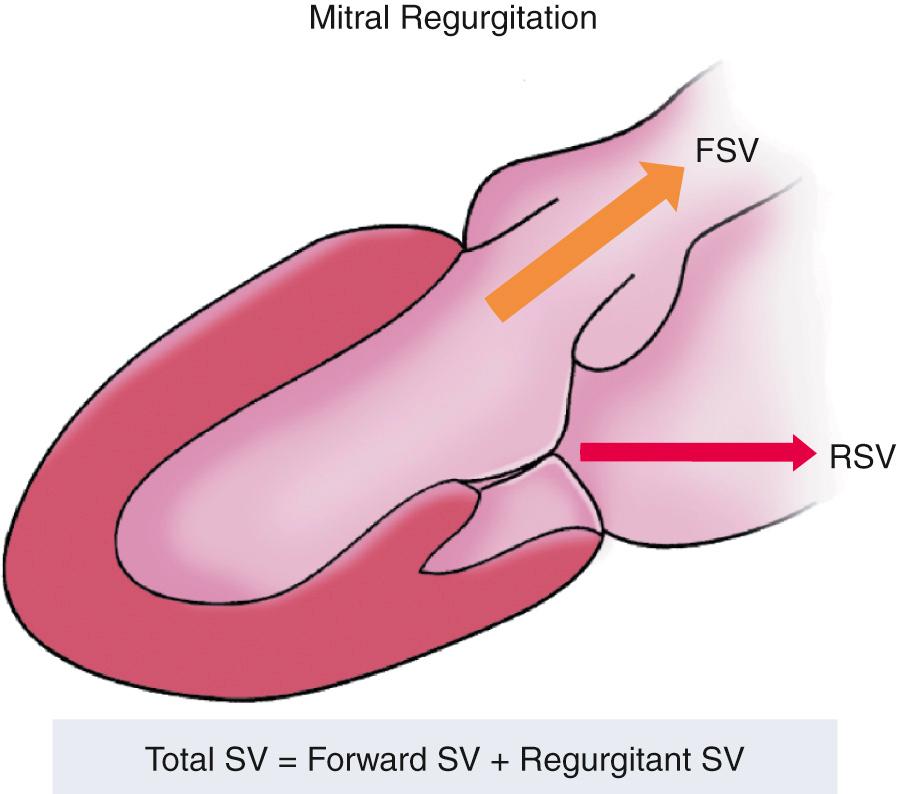
Chronic valvular regurgitation results in progressive volume overload of the ventricle. Volume overload of the LV results in chamber dilation with normal wall thickness so that total LV mass is increased. An important clinical feature of chronic LV volume overload is that an irreversible decrease in systolic function can occur in the absence of symptoms. In fact, an irreversible decrease in contractility can occur despite a normal ejection fraction because of the altered loading conditions of the ventricle when regurgitation is present.
Serial echocardiographic evaluation of LV size and systolic function is a standard method of clinical evaluation, but two factors potentially limit the reliability of this approach. First, suboptimal image quality or recording techniques results in erroneous measurements. Care is needed to ensure that the dimensions are measured perpendicular to the long and short axes of the LV, and instrument settings must be adjusted for optimal endocardial definition. Accurate tracing of endocardial borders for the calculation of ventricular volumes depends on clear endocardial definition, standard image planes without foreshortening of the long axis of the ventricle, and a trained and experienced individual tracing the borders at end-diastole and end-systole. With 2D imaging, left-sided contrast enhancement is recommended for accurate measurement of LV volumes and ejection fraction if endocardial definition is suboptimal. Calculation of LV volumes from a 3D volume acquisition avoids apical foreshortening or geometric assumptions and now is recommended whenever possible (see Chapter 6 ).
Second, the reproducibility of LV measurements must be considered. Overall reproducibility includes variation in recording the data, variation in measuring the data, and physiologic variation (e.g., heart rate and loading conditions) that affect the measurement. These sources of measurement variability affect all imaging approaches. When comparing serial studies, it is advisable to compare measurements on side-by-side images and to consider the limits of measurement variability for each approach. With 2D-guided M-mode measurements, an interval change of greater than 8 mm in end-systolic or end-diastolic dimensions represents a definite clinical change. Using 2D echocardiography, a change in ventricular volume or a change in ejection fraction greater than 10% on serial studies performed in the same laboratory indicates a significant change. 3D volumes have lower variability in recording and measuring data but are still subject to physiologic variability.
Valvular regurgitation can be detected with:
Color flow imaging
CW Doppler ultrasound
Although anatomic imaging provides detailed information about the valve apparatus and ventricular function, it provides only indirect evidence for the presence or absence of valvular regurgitation. The finding of an anatomically abnormal mitral valve in the presence of LA and LV dilation suggests that MR may be present, but Doppler examination is necessary for direct confirmation or exclusion of the diagnosis. Although a few M-mode findings have been shown to be specific for diagnosing valvular regurgitation (e.g., high-frequency fluttering of the anterior mitral leaflet in AR), these findings are not sensitive enough to exclude valve dysfunction reliably.
With color flow imaging, detection of regurgitation is based on identification of the flow disturbance downstream from the regurgitant orifice. When instrument settings and examination technique are optimal, color flow imaging is extremely sensitive (>90%) and specific (nearly 100%) for the detection of valvular regurgitation as compared with angiography. In fact, color flow imaging is so sensitive that regurgitation often is detected that is not audible by auscultation. These cases most often are true-positive results, as evidenced by angiographic confirmation. False-positive results can occur with color flow imaging when the origin or timing of the flow signal is mistaken. For example, normal pulmonary venous inflow into the LA sometimes is mistaken for MR. False-negative results occur when signal strength is low because of poor acoustic access or attenuation due to the depth of interrogation. False-negative results also occur if color flow processing parameters are set incorrectly or if the examiner fails to evaluate the valve in more than one tomographic plane. Additional parameters important in the detection of valvular regurgitation with color flow imaging include frame rate, Nyquist limit, color gain, and color velocity-variance display.
CW Doppler detection of valvular regurgitation is based on the identification of the high-velocity jet through the regurgitant orifice. An advantage of CW Doppler is that beam width is broad at the level of the valves when recorded from an apical approach. Identification of the regurgitant signal uses the velocity, shape, timing, and associated antegrade flow signal to identify the origin of the signal correctly ( Fig. 12.3 ).
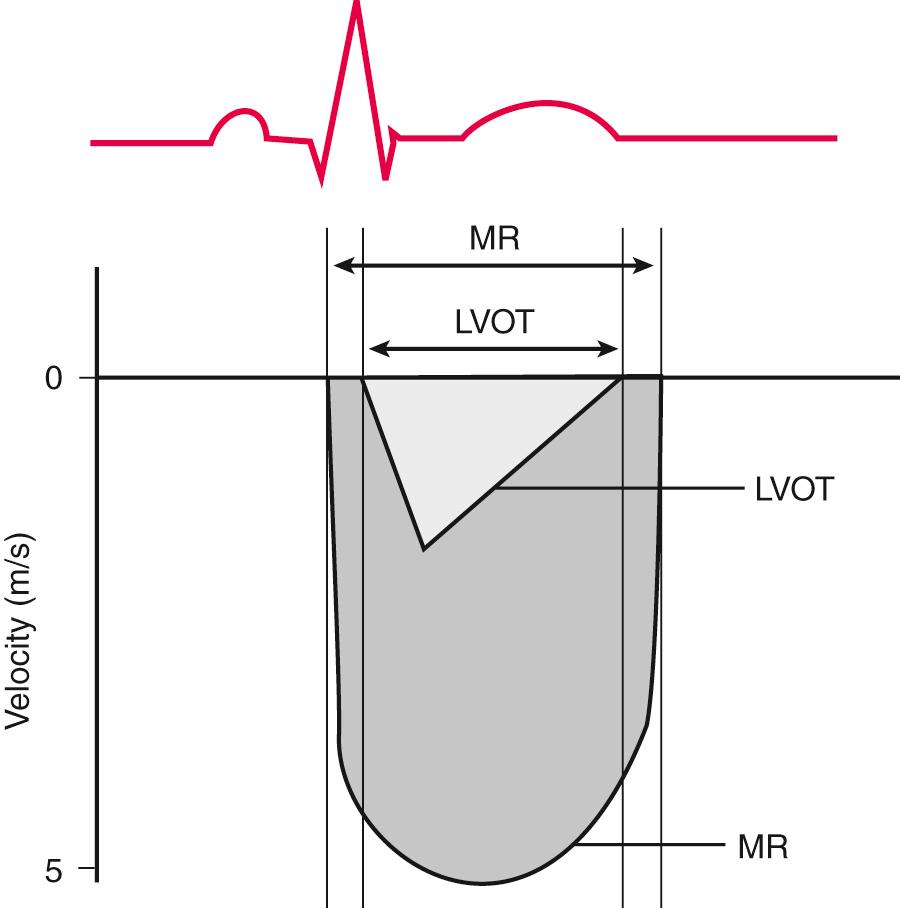
A small degree of regurgitation, often termed physiologic , is present in a high percentage of otherwise normal individuals ( Fig. 12.4 ). Typically, physiologic regurgitation is:
Spatially restricted to the area immediately adjacent to valve closure
Short in duration
Represents only a small regurgitant volume
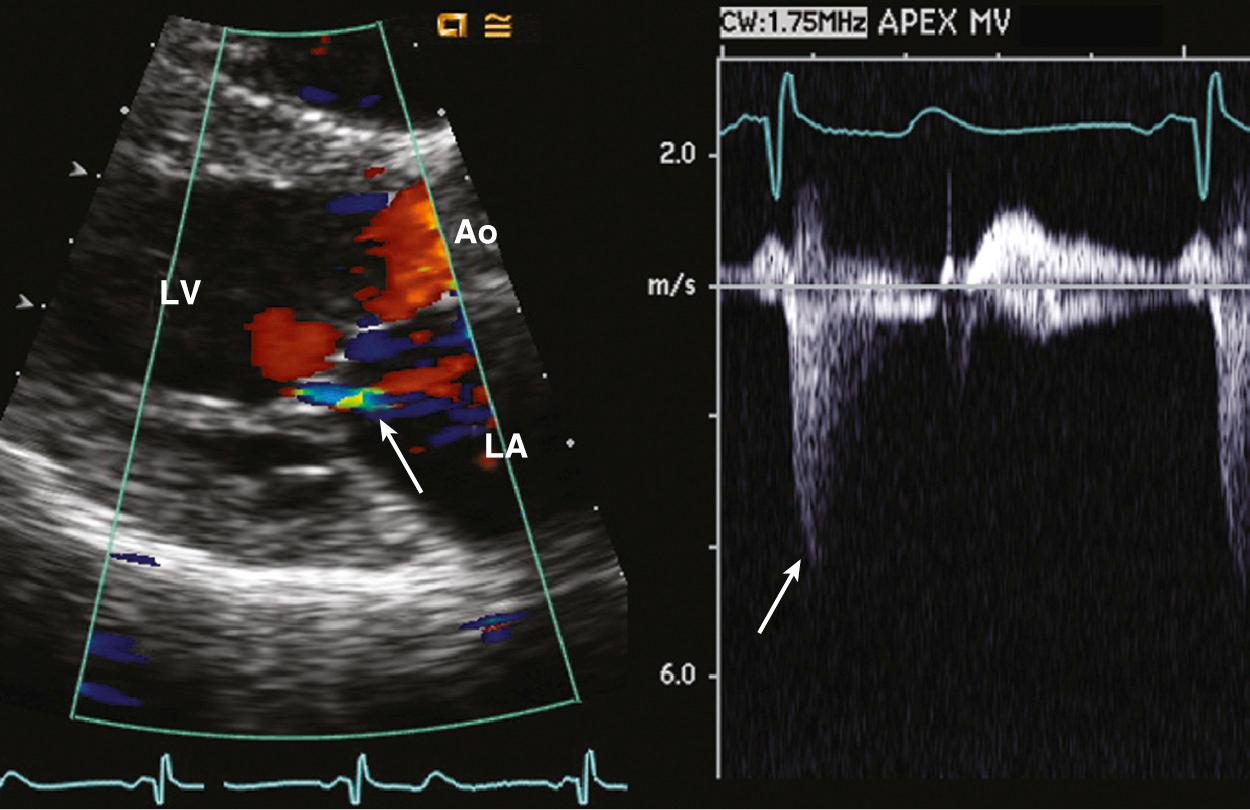
With a meticulous search for valve regurgitation, MR can be detected in 70% to 80%, tricuspid regurgitation in 80% to 90%, and pulmonic regurgitation in 70% to 80% of normal individuals. This small degree of regurgitation is normal and has no adverse clinical implications. AR is found in only a small percentage (5%) of young individuals with an otherwise normal echocardiographic study, but the prevalence of detectable AR increases with age. The clinical significance of a small amount of AR is unknown.
The severity of valvular regurgitation typically is described using semiquantitative measures as mild, moderate, or severe ( Table 12.3 ). The size of the color Doppler jet is not accurate for the evaluation of regurgitant severity. Instead, semiquantitative measures include:
Vena contracta width
CW Doppler signal strength compared with antegrade flow
Pressure half-time (for AR)
Distal flow reversals
| Method | Doppler Parameters | Limitations | Correlation With Other Imaging Modalities |
|---|---|---|---|
| Color flow imaging |
|
|
|
| CW Doppler |
|
|
|
| Vena contracta width |
|
|
|
| Proximal isovelocity surface area (PISA) |
|
|
|
| Volume flow at two sites |
|
|
|
| Distal flow reversals |
|
|
|
In addition, several quantitative measures (see Appendix B , Table B.15) of regurgitant severity have been well validated, including:
Regurgitant volume
Regurgitant fraction
Regurgitant orifice area
Regurgitant volume (RVol) is the retrograde volume flow rate across the valve, expressed either as an instantaneous flow rate in milliliters per second or (more correctly) averaged over the cardiac cycle in milliliters per beat. Regurgitant volume can be calculated by three different approaches:
PISA flow rate
Antegrade volume flow across the regurgitant valve minus the flow across a competent valve
Total LV stroke volume (SV total ) measured from LV volumes minus Doppler forward stroke volume
Regurgitant fraction (RF) is:
Regurgitant orifice area (ROA) is calculated, using the continuity equation, from regurgitant volume and the velocity-time integral of the regurgitant jet (VTI RJ ). Because the regurgitant volumes (RVol) proximal to and in the regurgitant orifice are equal,
solving for regurgitant orifice area gives
with RVol in cm 3 , VTI RJ in cm, and ROA in cm 2 .
In the past, regurgitant severity often was graded based on the size of the flow disturbance in the chamber receiving the regurgitant jet on a 1+ (mild) to 4+ (severe) scale. However, this grading system is quite inaccurate, particularly when regurgitation is more than mild, with substantial overlap in jet areas between patients with moderate and severe regurgitation. Color flow “mapping” also is subject to marked variability due to gain and other instrument settings, as well as physiologic variability. Thus, the area or length of a regurgitant jet is an unreliable indicator of disease severity and should not be used in patient management.
Color flow imaging of the regurgitant jet does remain clinically useful for the detection of valve regurgitation, for evaluation of the timing of flow, and for insights into the cause of regurgitation ( Figs. 12.5 and 12.6 ). Because color flow imaging basically is pulsed Doppler ultrasound with somewhat different signal processing and display formats, it is important to remember that signal aliasing still occurs. However, the usefulness of flow imaging depends on the timing and spatial location of the Doppler signals and not absolute blood flow velocity. Thus, signal aliasing does not limit the utility of flow imaging and, in fact, enhances the appreciation of abnormal flow patterns. In addition, flow imaging can be performed from windows where the intercept angle between the ultrasound beam and the direction of regurgitant flow is nonparallel. These windows often allow a shorter distance from the transducer to the flow region of interest, thereby resulting in a better signal-to-noise ratio. For example, AR is best evaluated from the parasternal approach ( Fig. 12.7 ). Although the direction of an AR jet in the parasternal long-axis view is nearly perpendicular to the ultrasound beam, multiple flow directions within the jet allow detection of the diastolic flow disturbance. Of course, an accurate blood velocity determination cannot be made both because of the nonparallel intercept angle and because the velocity exceeds the Nyquist limit of the pulsed Doppler mode.
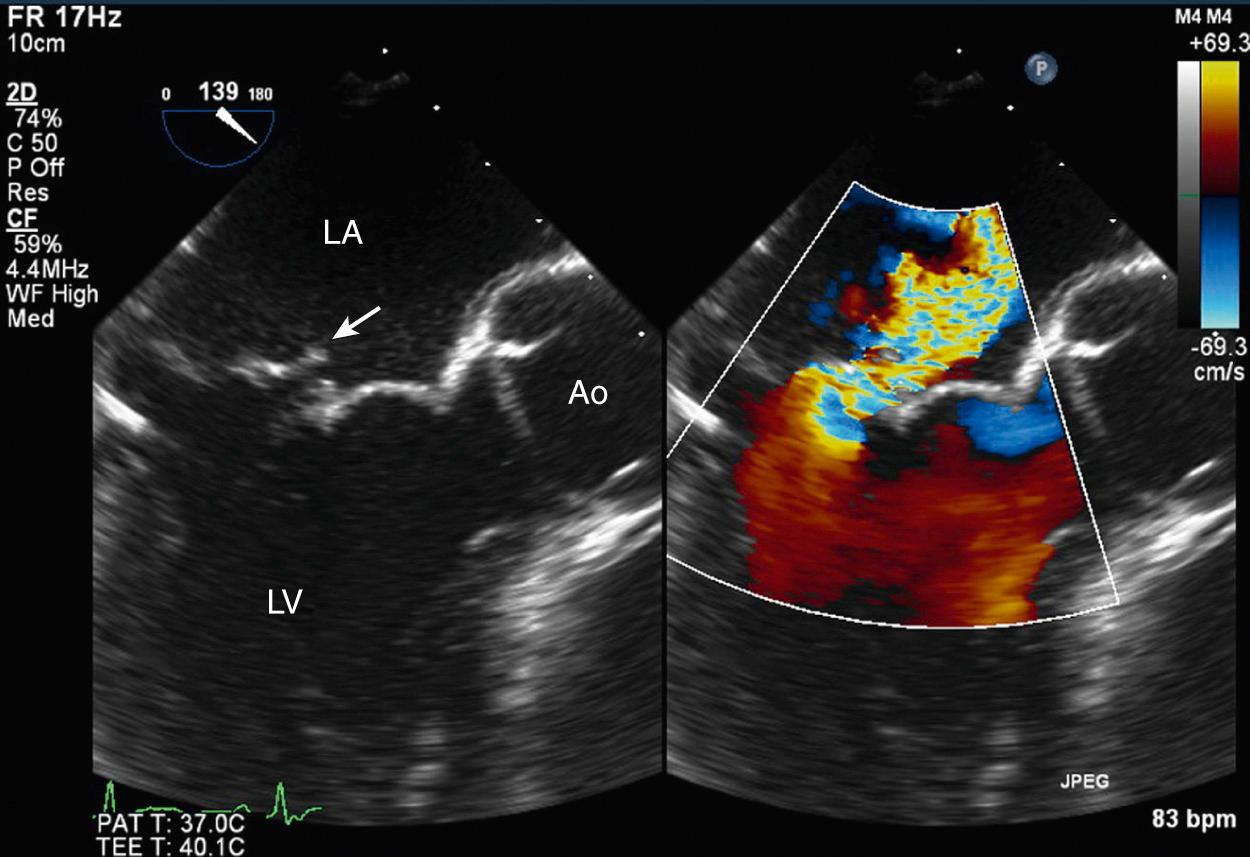
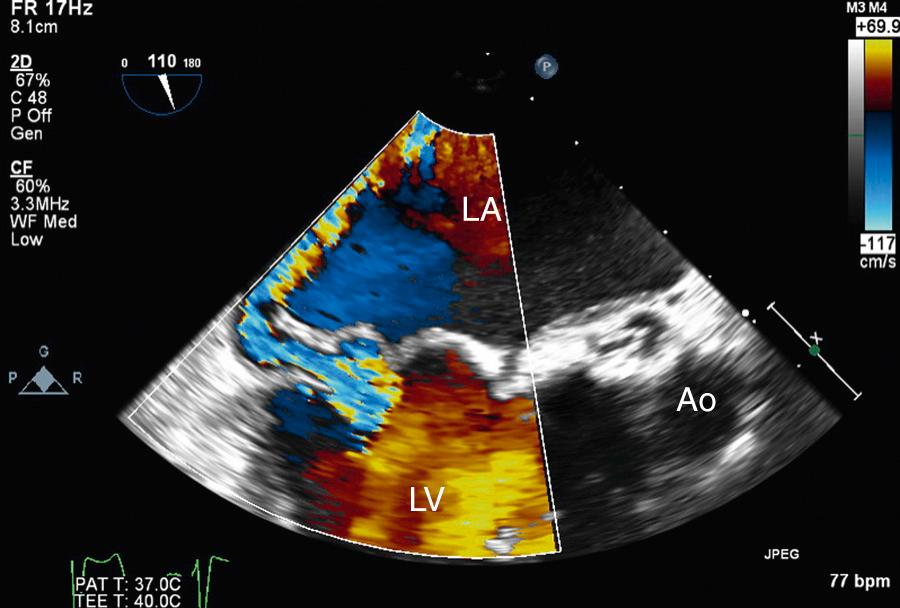
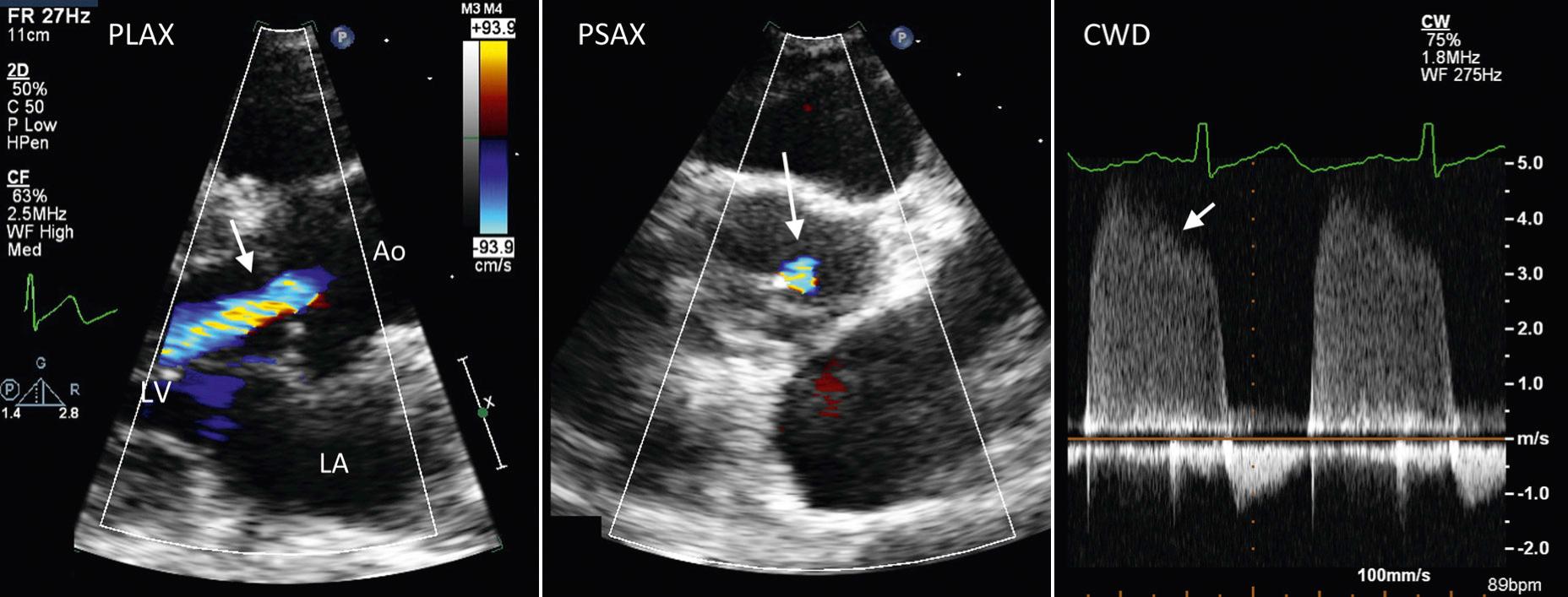
The appearance of a regurgitant jet with color flow imaging will vary depending on the ultrasound system, transducer frequency, and specific instrument settings. Correct visual interpretation depends on experience with a particular instrument and knowledge of the influence of instrument settings on the visual display. On most systems, a “variance” color scale results in a green regurgitant signal superimposed on the normal red-blue flow patterns. A “velocity” scale results in a mosaic of red, blue, and white pixels in the regurgitant jet. Because the goal of this application is to identify the location and timing of abnormal flow signals in a tomographic format, the exact color scale used is not particularly important as long as it displays the boundaries of the flow disturbance accurately.
Given the physics of pulsed Doppler color flow imaging, it is self-evident that an abnormal color pattern is not synonymous with abnormal flow. An abnormal color pattern can be seen even with normal intracardiac flow patterns; for example, the normal antegrade flow velocity of laminar flow across the aortic valve exceeds the Nyquist limit, resulting in aliasing and an “abnormal” color pattern. Conversely, abnormal flow signals do not demonstrate variance or a mosaic pattern if the flow velocities are within the Nyquist limit for that interrogation depth. For example, the low velocities seen in pulmonic regurgitation result in a uniform color display even though the flow pattern is abnormal. Interpretation of the color images will be most consistent from study to study if instrument settings and flow maps are standardized for each laboratory.
Recommended instrument settings for color flow imaging are:
Nyquist limit at the maximum for the imaging depth (60 to 80 cm/s)
Color gain setting just below random speckle from nonmoving targets
Maximum frame rate (e.g., narrow sector, decrease depth)
Consistent color velocity-variance display scale
Evaluation of the exact timing of a flow signal in relation both to valve closing and to the QRS complex can be helpful in correct identification of the signal. With color flow imaging, temporal resolution is sacrificed for spatial resolution because frame rates are far lower than the sampling rate of pulsed or CW Doppler. Simultaneous recording of an electrocardiographic lead is essential for frame-by-frame analysis of the color flow images to verify the timing of the disturbance.
The vena contracta, the narrowest diameter of the flowstream, reflects the diameter of the regurgitant orifice with the advantages that it is independent of volume flow rate and driving pressure and that it is relatively unaffected by instrument settings. However, because vena contracta diameters have a narrow range of values, care is needed to obtain adequate images for measurement. To optimize both temporal and spatial resolution, the recommended approach to measurement of vena contracta is to use a view:
Perpendicular to jet width
Zoom mode
Narrow sector
Minimum depth
Angulation out of the standard image planes is needed to depict both the proximal acceleration region and downstream flow expansion for accurate identification of the vena contracta ( Fig. 12.8 ).
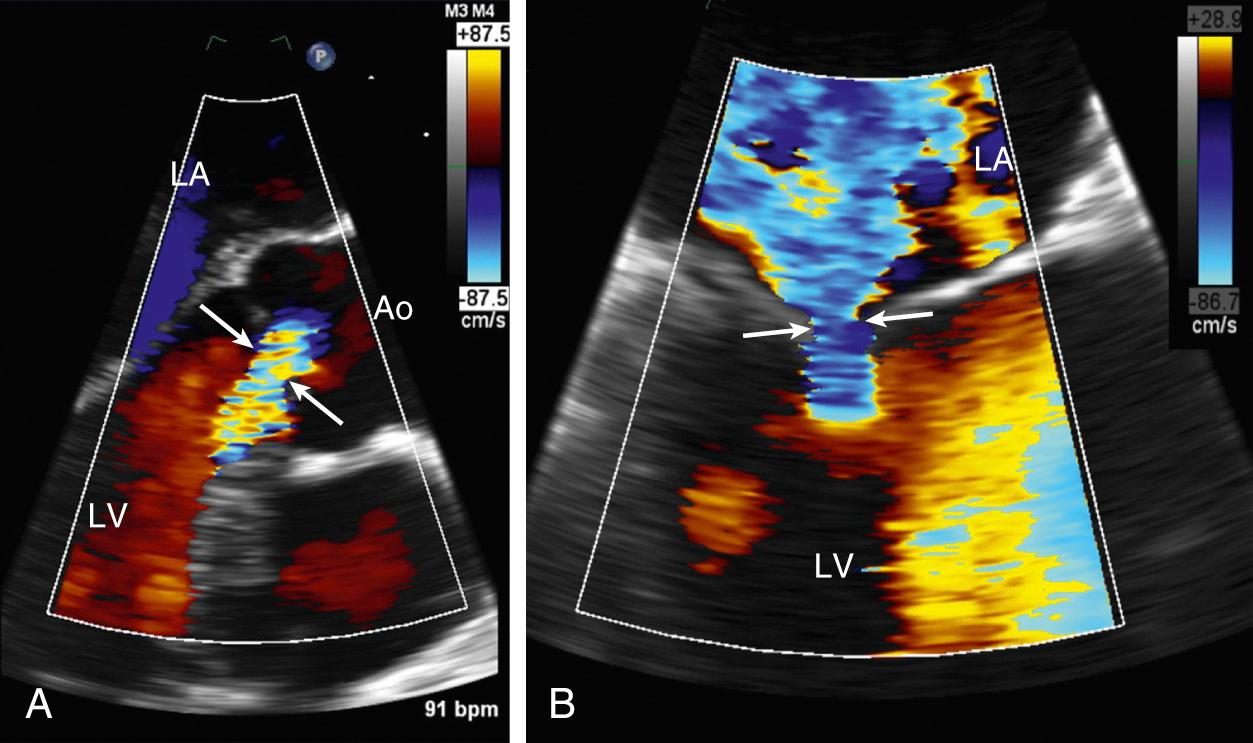
Vena contracta diameter varies with dynamic changes in regurgitant orifice area, for example, with late-systolic MR due to mitral valve prolapse. However, vena contracta width remains accurate in the setting of acute regurgitation, whereas jet area is misleading. The 3D visualization of vena contracta area shows promise, particularly for nonsymmetrical regurgitant orifices, but this technique is limited by low frame rates, and it can be challenging to acquire adequate-quality 3D color images, even with TEE imaging ( Fig. 12.9 ).
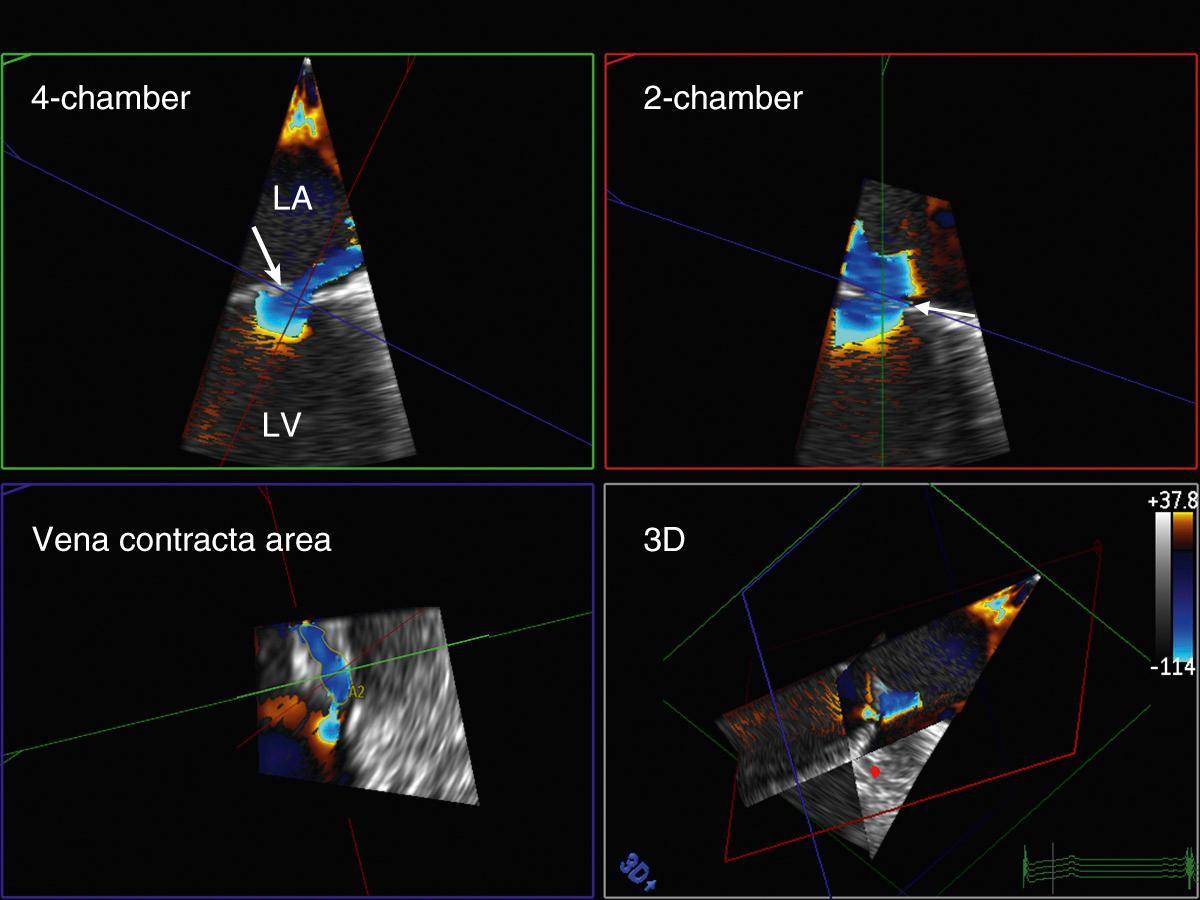
Color flow imaging allows for the calculation of the retrograde volume flow rate based on measurement of the flow convergence region proximal to the regurgitant orifice. Acceleration of flow occurs proximal to the valve plane with, in concept, a series of isovelocity “surfaces” leading to the high-velocity jet in the regurgitant orifice. Immediately adjacent to the orifice, these surfaces are small with higher flow velocities; at increasing distances from the orifice, areas are larger and velocities are lower. Based on the principle of volume flow calculation by Doppler techniques, the volume flow rate (in this case, regurgitant flow) for a PISA, when averaged over the temporal flow period ( Fig. 12.10 ), is
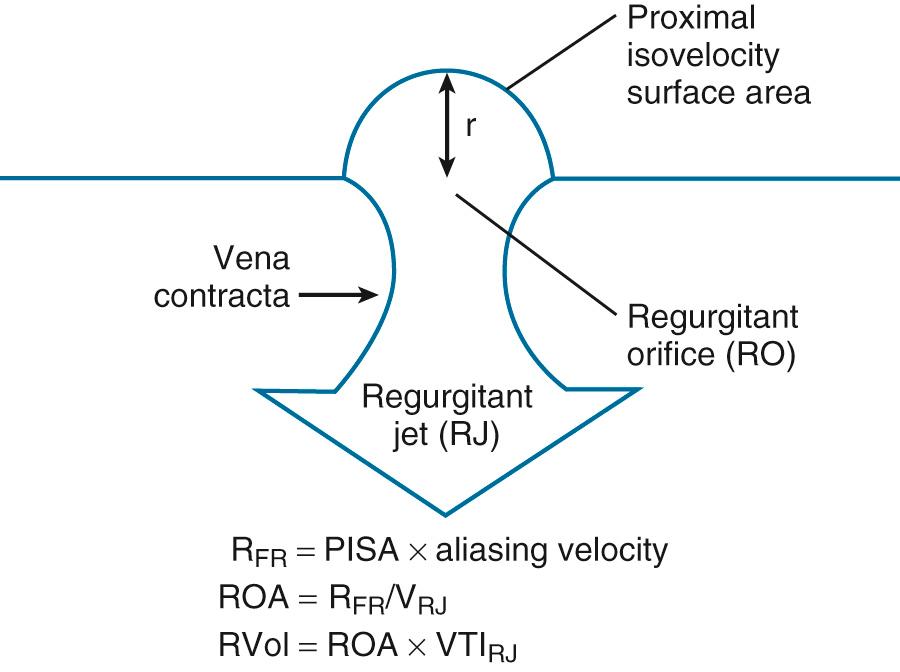
The velocity of the PISA can be determined from the color flow image as the aliasing velocity where a distinct red-blue interface is seen ( Fig. 12.11 ). At this interface, the velocity is known, being equivalent to the Nyquist limit on the velocity color scale. The size of the PISA can be maximized to allow more accurate regurgitant flow rate calculations using a zoomed image with the Doppler velocity baseline shifted so that the aliasing velocity is 30 to 40 cm/s in the direction of flow.
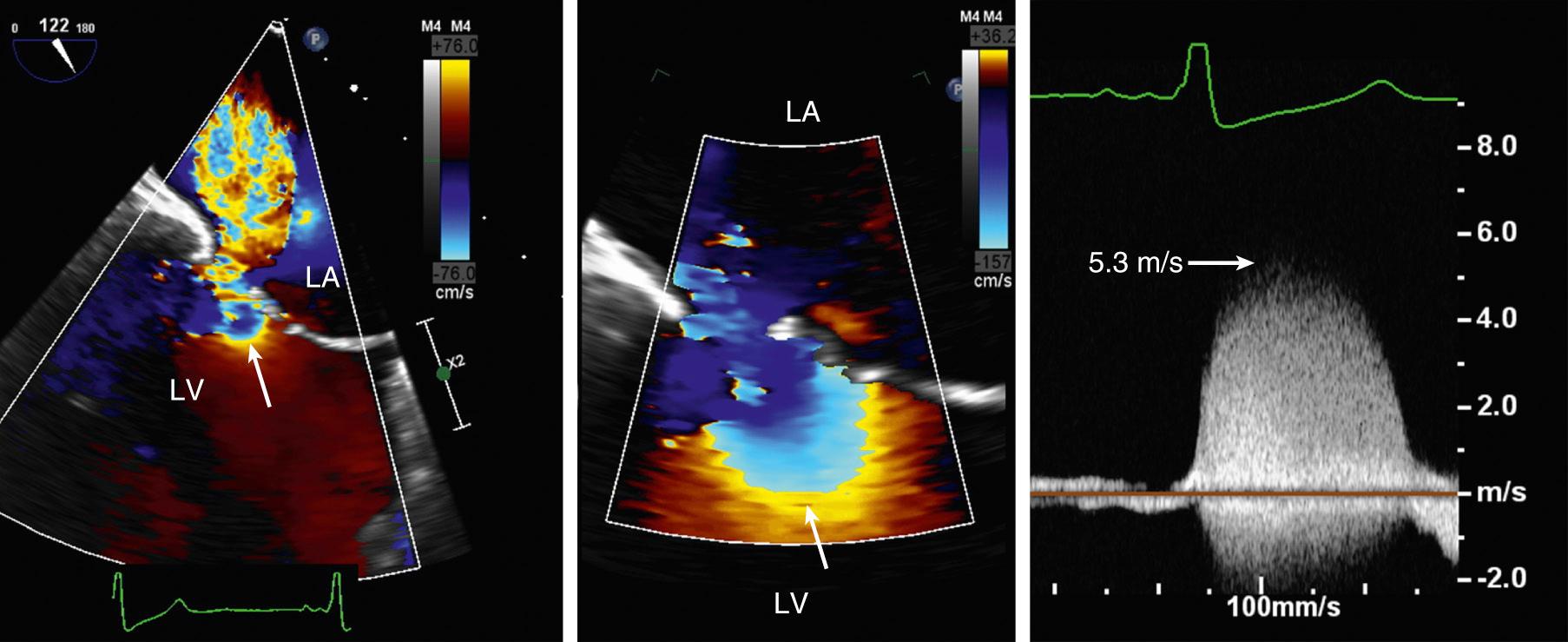
The shape of the isovelocity surface proximal to a regurgitant valve typically is hemispherical, with a tendency toward a hemielliptical shape closer to the orifice. Assuming a hemispherical shape, the PISA is calculated from measurements of the distance from the aliasing velocity to the regurgitant orifice as the surface area of a hemisphere:
Note that the PISA method for calculating regurgitant volume is analogous to calculation of stroke volume proximal to a stenotic valve. The differences between these approaches are (1) the differing shapes of the proximal velocity stream lines; (2) the use of color flow, rather than pulsed Doppler, to measure velocity at a given location; and (3) the need for temporal averaging when color data from single images are used.
The PISA method can be combined with the velocity-time integral of CW Doppler flow through the regurgitant orifice to calculate regurgitant orifice area using Eq. 12.3 . Instead of averaging PISA over the duration of flow, most clinicians calculate the maximum instantaneous regurgitant orifice area (ROA max in cm 2 ) based on the maximum regurgitant flow rate (R FR in milliliters per second) combined with maximum MR jet velocity (V MR in centimeters per second):
This approach assumes that R FR and V MR occur at the same time point in the cardiac cycle. The PISA should be recorded in a view parallel to the flowstream, typically an apical four-chamber view for MR, using a narrow sector and zoom mode, with the aliasing velocity adjusted to optimize visualization of a hemispherical aliasing boundary. If the PISA is hemielliptical or if the valve is nonplanar, an alternate approach should be used or appropriate corrections should be made in the calculations.
Several types of information regarding the severity of valvular regurgitation can be derived from the spectral display of the CW Doppler signal:
Signal intensity relative to antegrade flow
Antegrade flow velocity
Time course (shape) of velocity curve
First, signal intensity is proportional to the number of blood cells contributing to the regurgitant signal. Because the ultrasound beam is relatively broad and signals from the entire length of the beam are recorded, much of the regurgitant jet can be encompassed in the beam with appropriate adjustment of beam direction. It is particularly helpful to compare the intensity of the regurgitant signal with antegrade flow across the same valve as a qualitative estimate of regurgitant severity (see Fig. 12.11 ). A weak signal reflects mild regurgitation, whereas a signal nearly equal in intensity to antegrade flow reflects severe regurgitation. Moderate regurgitation has intermediate signal strength relative to antegrade flow.
Second, the associated antegrade velocity across the regurgitant valve provides useful information. Regurgitation results in an increase in the antegrade volume flow rate across the valve, which is reflected in an increase in the antegrade velocity across the valve. The greater the severity of regurgitation, the higher is the antegrade velocity. Of course, the possibility of coexisting valvular stenosis also must be considered.
Third, the shape of the velocity curve depends on the time-varying pressure gradient across the regurgitant valve. Each instantaneous velocity is related to the instantaneous pressure gradient across the valve, as stated in the Bernoulli equation. Normal LV systolic pressure is 100 to 140 mmHg, and normal LA pressure is 5 to 15 mmHg, so the LV to LA pressure difference in systole is 85 to 135 mmHg. Thus, the MR velocity curve typically shows a maximum velocity of 5 to 6 m/s. When ventricular function is normal, rapid acceleration to peak velocity occurs, with a maintained high velocity in systole and with rapid deceleration before diastolic opening of the mitral valve. An increase in end-systolic LA pressure (v- wave) results in a late-systolic decline in the instantaneous pressure gradient and in the instantaneous velocity ( Fig. 12.12 ).
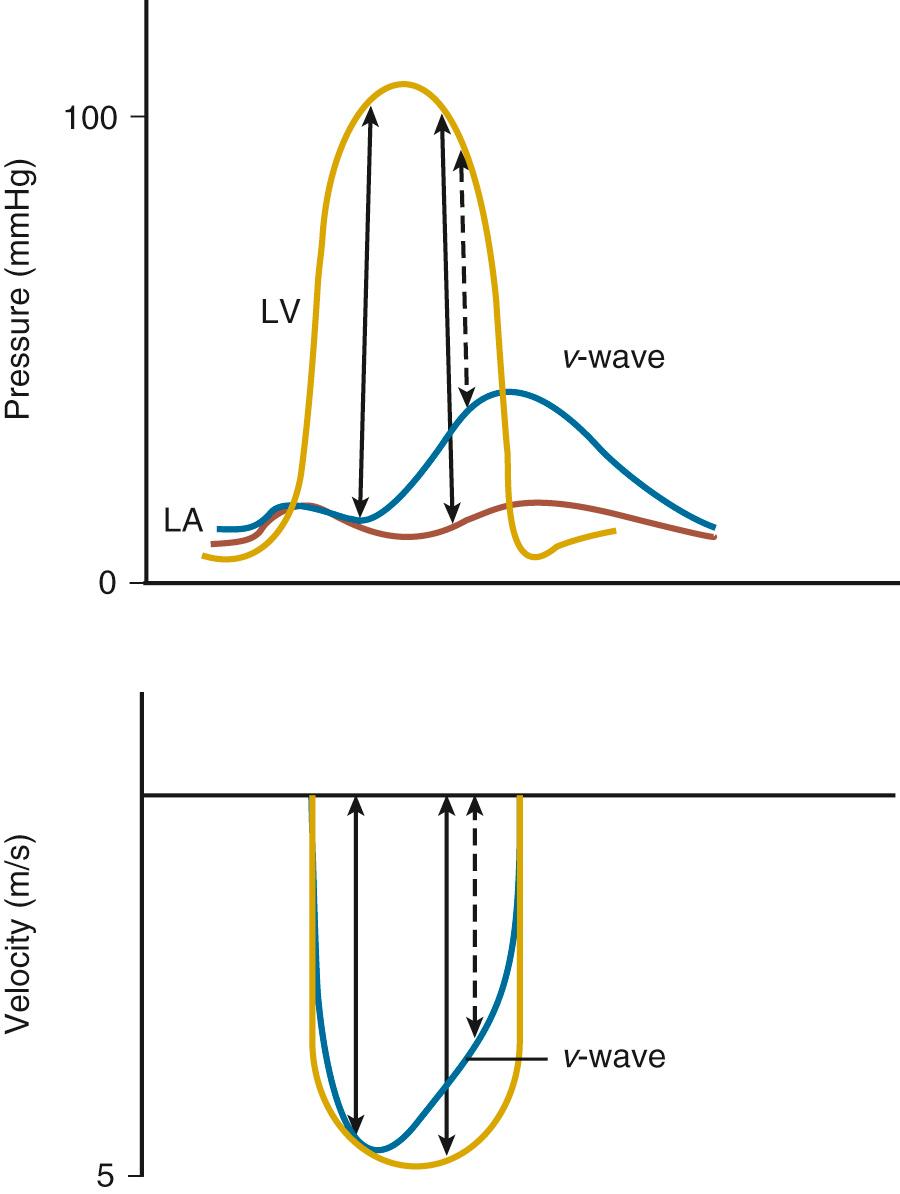
Similarly, the shape of the AR velocity curve depends on the time course of the diastolic pressure difference across the aortic valve. When LV end-diastolic pressure is low and aortic end-diastolic pressure is normal or mildly reduced, a large pressure difference (and high velocity) across the valve is present throughout diastole with a slow rate of pressure decline ( Fig. 12.13 ). Acute or severe regurgitation results in more rapid equalization of LV and aortic pressures with a more rapid velocity decline in diastole.
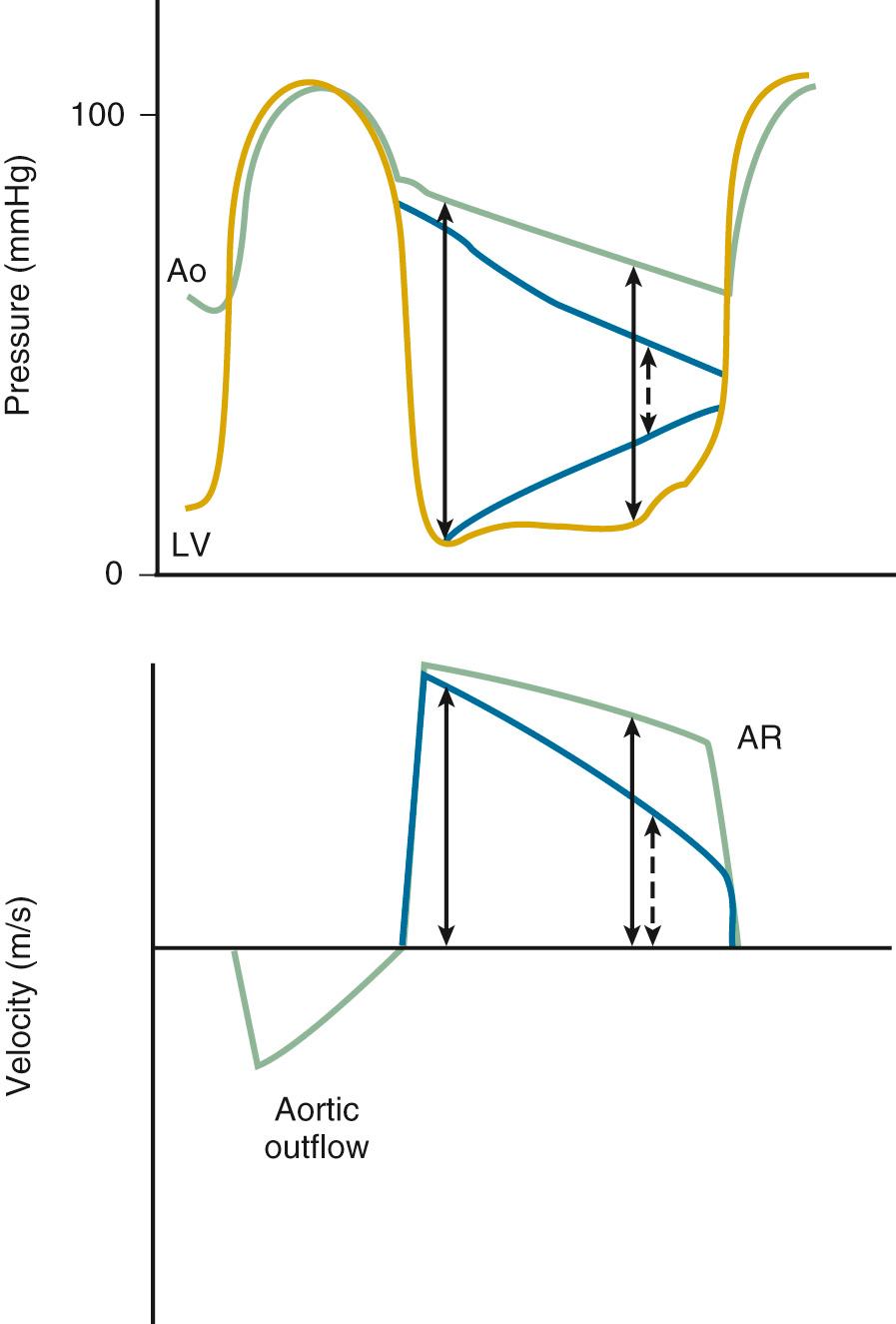
The utility of the CW Doppler curve depends, in large part, on technical factors in data recording in addition to correct data interpretation. The high-velocity regurgitant signal is optimized by:
Sweep speed of spectral display at 100 mm/s
Velocity range adjusted so that signal of interest fits but fills the screen
High-pass (“wall”) filter set at the maximum level
Gain and dynamic range adjusted to show dark outer edge of the velocity curve
Examination from multiple acoustic windows
Adjustment of transducer position and angulation
Optimal patient positioning, examination from multiple windows, and transducer angulation are needed to ensure a near-parallel intercept angle between the direction of the ultrasound beam and the regurgitant jet to avoid underestimation of velocities. Use of a dedicated, small CW transducer often facilitates the examination and provides a better signal-to-noise ratio than 2D-guided CW Doppler. In addition, the 2D image often distracts the examiner from searching for the highest-velocity signal. Color flow imaging is of limited value for locating the best CW signal because it provides only 2D information; jet direction in the elevation plane remains unknown. Temporal factors also affect data quality, and caution is needed in interpreting the shape of the velocity curve if jet direction (and thus the Doppler-jet intercept angle) varies during the regurgitant flow period.
When atrioventricular valve regurgitation is severe enough that a significant volume of blood is displaced by the regurgitant jet, flow reversal is seen in the veins entering the atrium. With severe tricuspid regurgitation, the normal pattern of systolic inflow into the right atrium (RA) from the superior and inferior vena cavae is reversed. This can be demonstrated with a pulsed Doppler sample volume positioned in the central hepatic vein ( Fig. 12.14 ). Severe MR results in reversal of the normal patterns of systolic inflow into the LA from the pulmonary veins. This usually is difficult to demonstrate on a transthoracic study because of signal attenuation at the depth of the pulmonary vein but is easily recorded from a TEE approach ( Fig. 12.15 ). Systolic flow reversal in the pulmonary veins (for MR) or in the hepatic veins (for tricuspid regurgitation) is only useful when sinus rhythm is present because normal venous inflow patterns often are abnormal with other cardiac rhythms, such as atrial fibrillation.
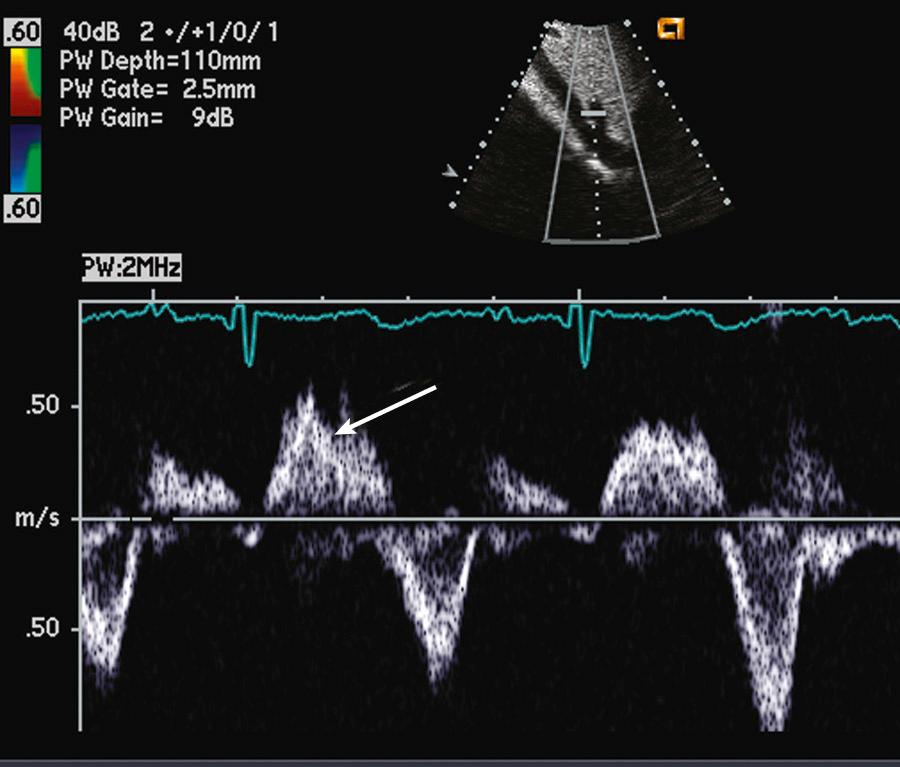
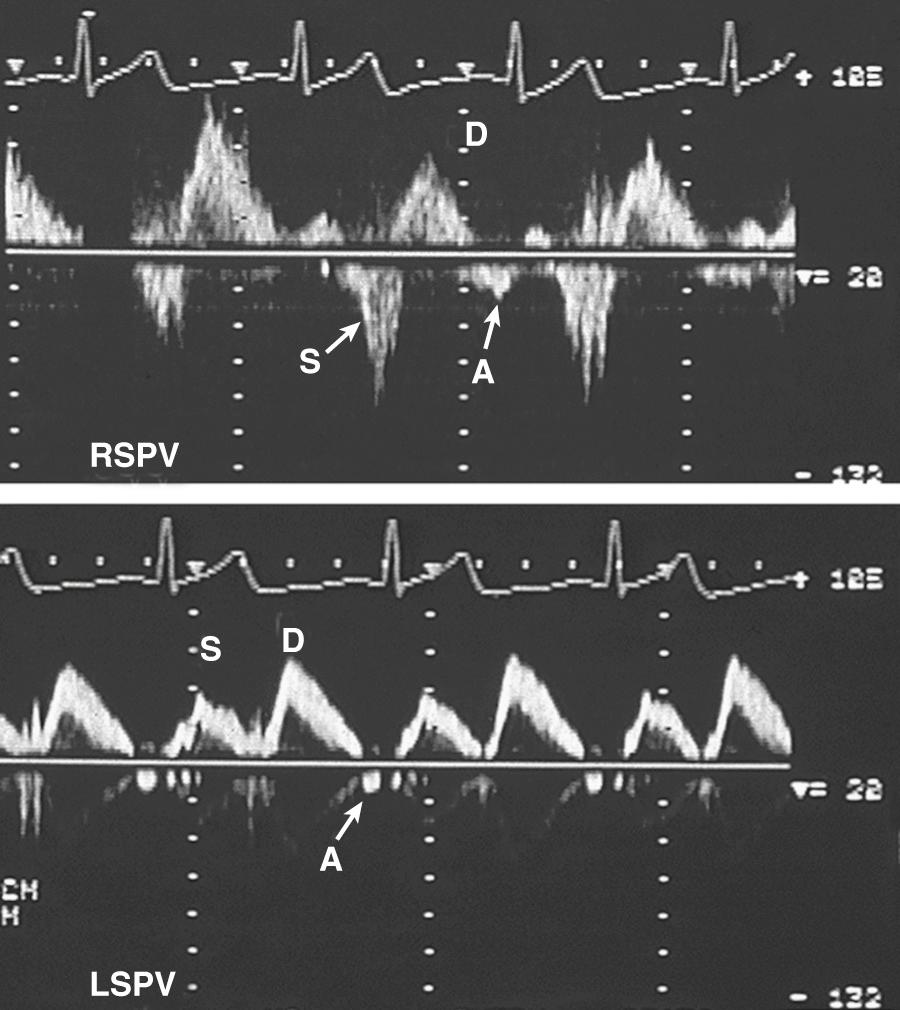
Regurgitation of a semilunar valve results in reversal of flow in the associated great vessel as blood flows from the great vessel across the incompetent valve into the ventricle. The distance from the valve plane that this flow reversal extends in the great vessel is proportional to regurgitant volume. For example, with severe AR, holodiastolic flow reversal is seen in the proximal abdominal aorta. With moderate regurgitation, holodiastolic flow reversal extends only to the descending thoracic aorta.
Regurgitant stroke volume can be calculated using 2D diameter measurements in conjunction with pulsed Doppler flow velocities at two intracardiac sites. Total stroke volume is calculated from antegrade flow across the regurgitant valve as the cross-sectional area of flow times the velocity-time integral of transvalvular flow. Forward stroke volume is calculated as antegrade flow across a different (and nonregurgitant) valve ( Fig. 12.16 ).
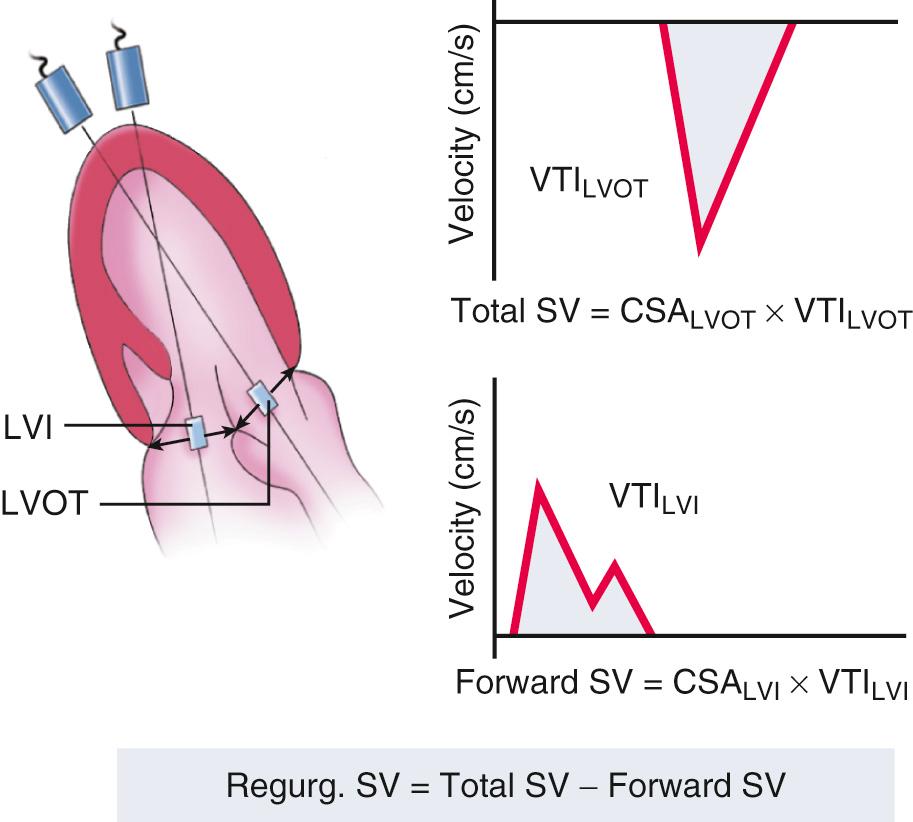
For example, with AR, transaortic stroke volume (SV) represents total LV stroke volume and can be calculated as:
where CSA is cross-sectional area, VTI is the velocity-time integral, and LVOT is the LV outflow tract. Forward stroke volume is represented by LV inflow across the mitral annulus (MA), because the amount of blood filling the ventricle equals the amount of blood delivered to the body on each beat, and can be calculated as:
With AR, alternate sites for the measurement of forward stroke volume are the pulmonary artery and right ventricular (RV) inflow region. Regurgitant volume is calculated as:
Regurgitant fraction and regurgitant orifice area then are calculated with Eqs. 12.1 and 12.3 . Alternatively, total stroke volume can be derived from 2D or 3D imaging of the LV with identification of endocardial borders at end-diastole and end-systole.
Calculation of regurgitant volume and regurgitant fraction from volume flow at two intracardiac sites has been shown to be accurate in animal models and in selected patient series. However, small errors in diameter measurement lead to large errors in cross-sectional area calculations because of the quadratic relationship between the two (CSA = π r 2 ). Other potential pitfalls in volume flow measurement are discussed in detail in Chapter 6 . This method clearly can provide accurate quantitation of regurgitant severity when image quality is excellent; in other cases, it is helpful to compare the antegrade velocity-time integral (or peak velocity) for the regurgitant valve with the antegrade flow across a competent valve as an indicator of their relative stroke volumes.
Echocardiography is the clinical standard for the evaluation of valvular regurgitation. The diagnostic value of the echocardiographic study is increased when the interpretation integrates data from several potential measures of regurgitant severity into a summary statement. Rather than being redundant, the different approaches to regurgitant severity serve as cross-checks on one another. Errors or limitations of one approach will be recognized when other approaches, with better data quality, show discrepant results. Current guidelines recommend an integrative approach to evaluation of regurgitant severity based on multiple quantitative and semiquantitative measurements, as well as consideration of valve anatomy, LV size, and systolic function and pulmonary pressures. Because valvular regurgitant is dynamic and varies with loading conditions, it is essential to record blood pressure at the time of the echocardiographic examination.
When transthoracic data are suboptimal, TEE is the next step. If further data are needed for clinical decision making, other approaches can be considered. Cardiac magnetic resonance imaging provides quantitative measures of ventricular size and systolic function and of regurgitant volume and fraction ( Fig. 12.17 ), and it is more reproducible than echocardiography for quantitation of AR. Cardiac catheterization can be used to measure intracardiac pressures, angiographic visualization of regurgitation, and calculation of quantitative measures of regurgitant severity.
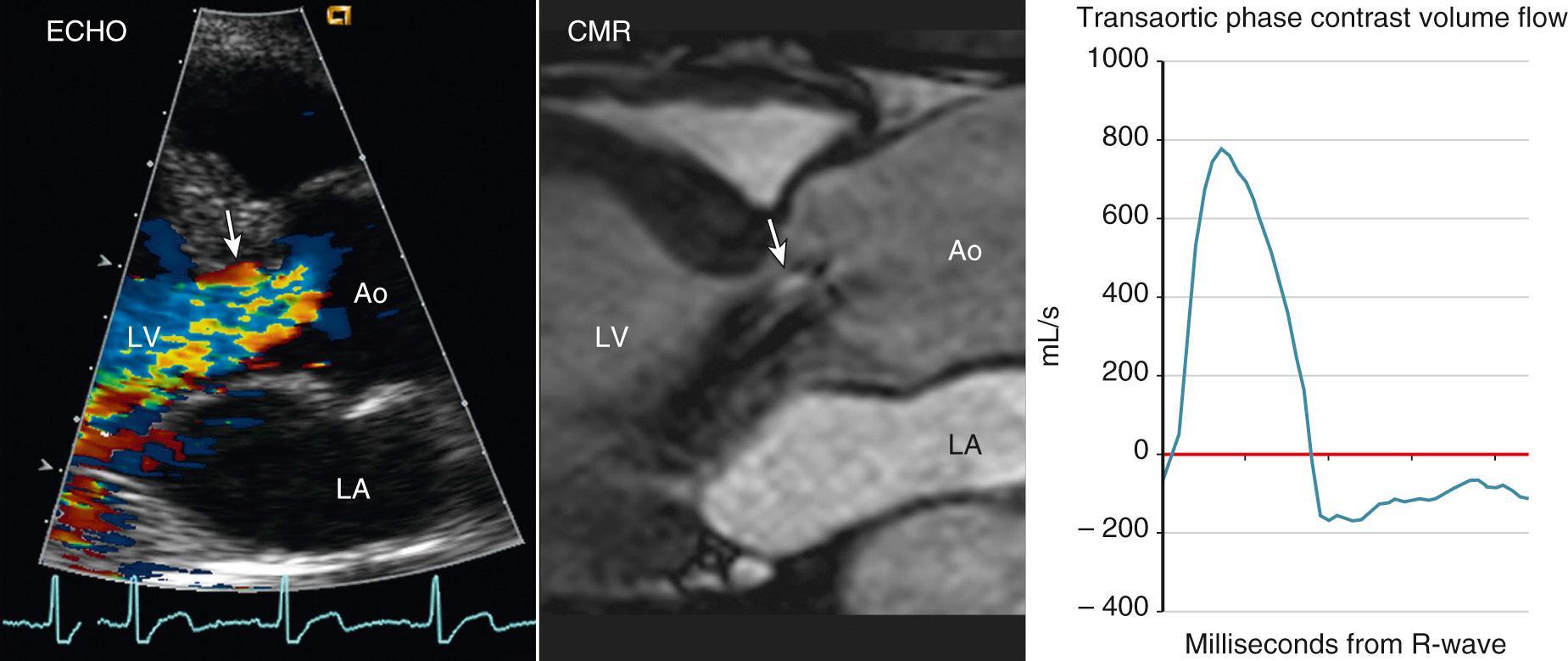
The echocardiographic approach to the patient with AR includes not only evaluation of the presence of regurgitation but also the etiology and severity of regurgitation along with effects of the regurgitant lesion on ventricular size and function.
AR is due either to abnormalities of the aorta or to abnormalities of the leaflets themselves ( Table 12.4 ). The disease processes that cause valvular aortic stenosis (congenital bicuspid valve, calcific valve disease, and rheumatic disease) also can result in AR because of alterations in leaflet flexibility or shape leading to inadequate diastolic coaptation of the leaflets. The imaging findings for these diagnoses are discussed in Chapter 11 .
| Chronic Primary AR | Chronic AR Due to Aortic Disease | Acute AR | |
|---|---|---|---|
| Causes (examples) |
|
|
|
| Clinical presentation and disease course |
|
|
|
| LV response |
|
|
|
| Valve anatomy |
|
|
|
| Key Doppler findings |
|
|
|
| Definition of severe AR |
|
|
|
| Indications for intervention with severe AR * |
|
|
|
| Options for intervention |
|
|
|
* Major accepted indications for intervention; guidelines should be consulted for other indications and more details.
Other diseases that cause AR include myxomatous valve disease , which can affect the aortic valve in addition to the mitral valve. The leaflets are thickened and redundant on 2D or 3D imaging with slight sagging of the leaflets into the LV outflow tract in diastole. The normal hemicylindrical configuration of each leaflet in diastole is distorted so that the short-axis view intersects the center of the leaflet en face , thus resulting in the false appearance of an ill-defined echogenic “mass.”
Endocarditis results in AR either by leaflet perforation due to the infectious process or to deformity of diastolic leaflet closure resulting from the presence of a vegetation ( Fig. 12.18 ). Less common abnormalities of the aortic valve leaflets leading to AR include congenital leaflet fenestrations, nonbacterial thrombotic endocarditis (e.g., systemic lupus erythematosus), infiltrative diseases (e.g., amyloidosis), systemic inflammatory diseases (e.g., ankylosing spondylitis), mucopolysaccharidosis, and glycogen storage diseases.
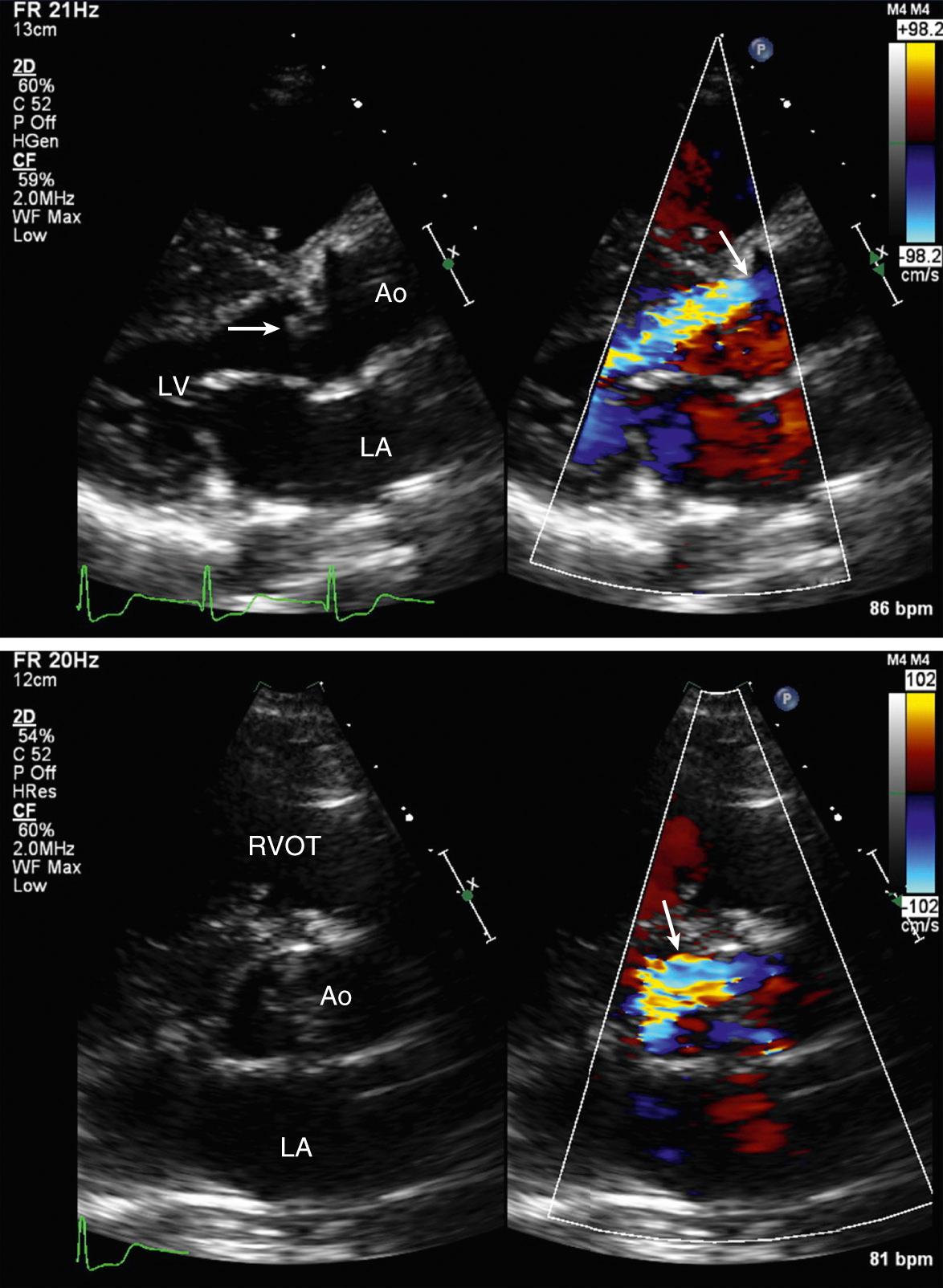
Abnormalities of the aorta can result in AR, even when the leaflets themselves are normal, by alterations in the geometry of the structures supporting the leaflets. The aortic annulus is not a discrete planar ring of fibrous tissue but rather a complex, crown-shaped structure where the leaflets attach to the aortic valve with the three “points” of the crown at the commissures and the three lowest points at the midsection of each leaflet. Dilation of this area at the base of the aorta—often termed annular dilation— results in AR because of inadequate coaptation of the stretched leaflets. Note that adjacent leaflets normally overlap (apposition zone), so mild degrees of annular dilation do not result in valvular incompetence. Annular dilation has a variety of causes, including chronic hypertension, cystic medial necrosis, or Marfan syndrome . Marfan syndrome is characterized by effacement of the normal sinotubular junction with dilation of the annulus and sinuses of Valsalva (see Chapter 16 ). In cystic medial necrosis, the sinotubular junction usually is identifiable, although dilation typically involves the sinuses in addition to the ascending aorta. Bicuspid aortic valve disease often is associated with significant dilation of the aortic sinuses and ascending aorta. AR due to syphilitic aortitis is rare in the United States. When present, it typically is characterized by extensive calcification of the dilated ascending aorta. Aortic dissection can result in AR either by annular dilation leading to inadequate coaptation or by the false channel of the dissection undermining the aortic annulus and resulting in a flail leaflet (see Chapter 16 ).
The differential diagnosis for the echocardiographer in the evaluation of a patient referred for suspected AR depends on the specific indications for the examination. If a diastolic murmur has been noted on auscultation, differential diagnoses include pulmonic regurgitation, mitral or tricuspid stenosis, and (rarely) a coronary arteriovenous fistula. In some cases, only the diastolic portion of a continuous murmur (e.g., a patent ductus arteriosus) is appreciated on auscultation. If AR is suspected because of a concern for aortic dissection, the differential diagnosis should focus on examination of the ascending aorta.
When exposed to chronic volume overload from AR, the LV progressively dilates and becomes more spherical ( Fig. 12.19 ). Initially, LV systolic function remains normal. With chronic gradually increasing AR, the LV remains compliant in diastole, so end-diastolic pressure remains normal. Typically, LV size slowly increases over a period of years without impairment of systolic function. However, LV systolic dysfunction eventually occurs in the presence of hemodynamically significant chronic volume overload, and in some individuals, irreversible LV systolic dysfunction supervenes even in the absence of clinical symptoms.
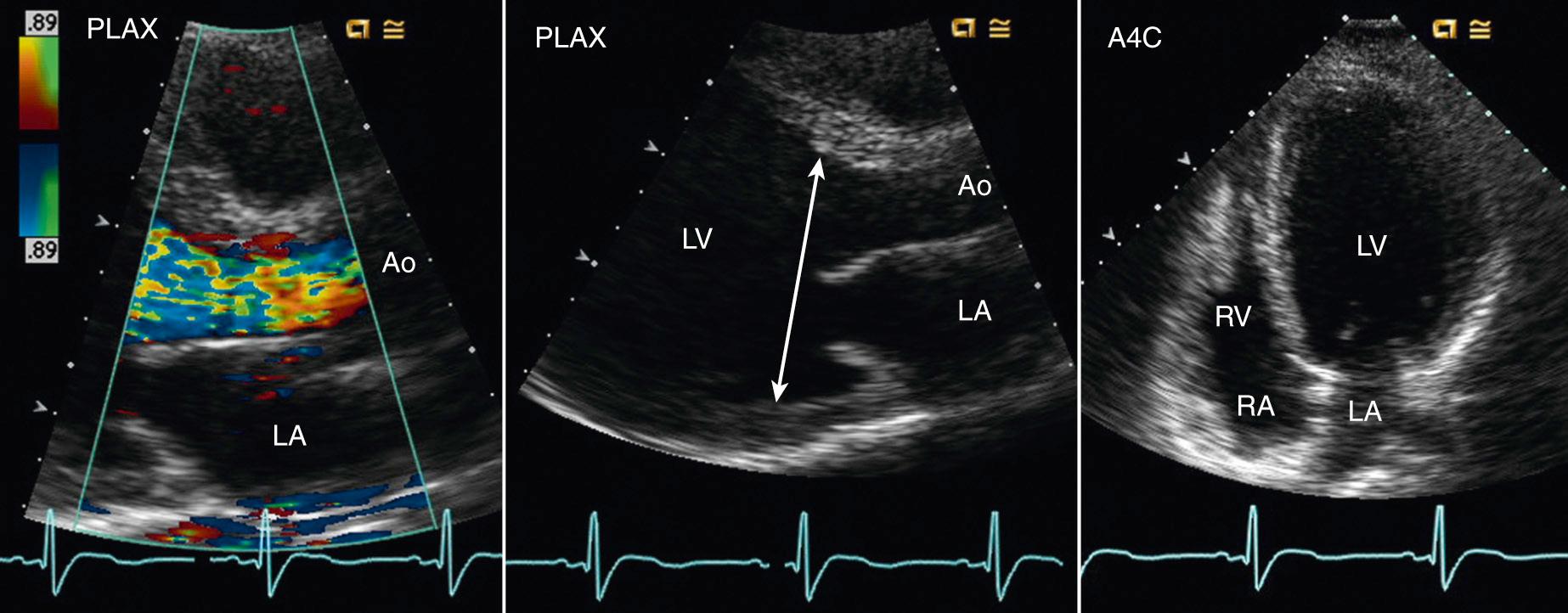
In contrast to chronic regurgitation, in acute AR, the short interval from the onset of volume overload to clinical presentation means that significant LV dilation has not yet occurred. The physiologic differences between acute and chronic AR are reflected both in the 2D echocardiographic findings and in the Doppler examination.
Become a Clinical Tree membership for Full access and enjoy Unlimited articles
If you are a member. Log in here